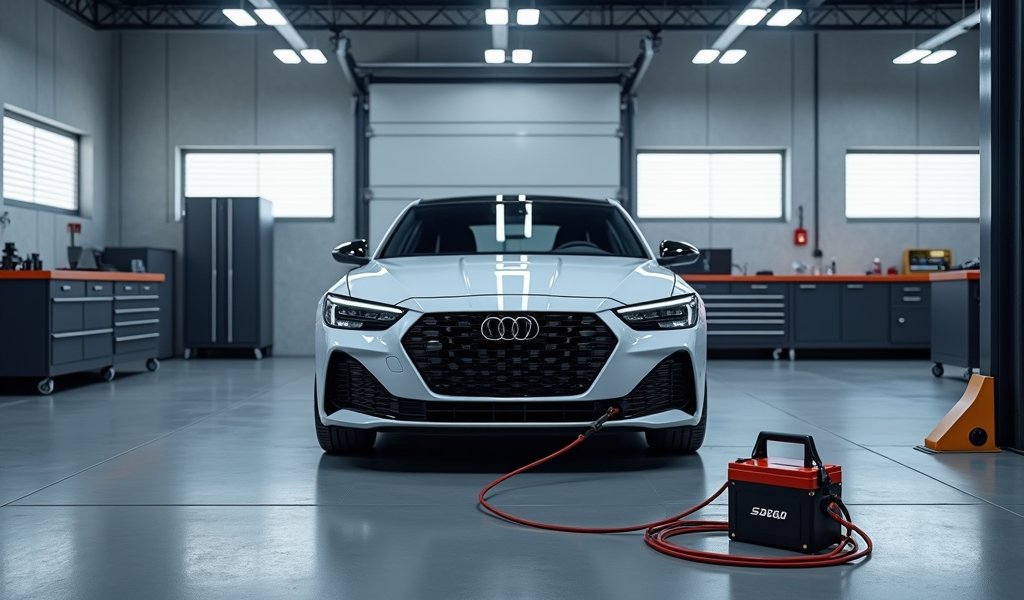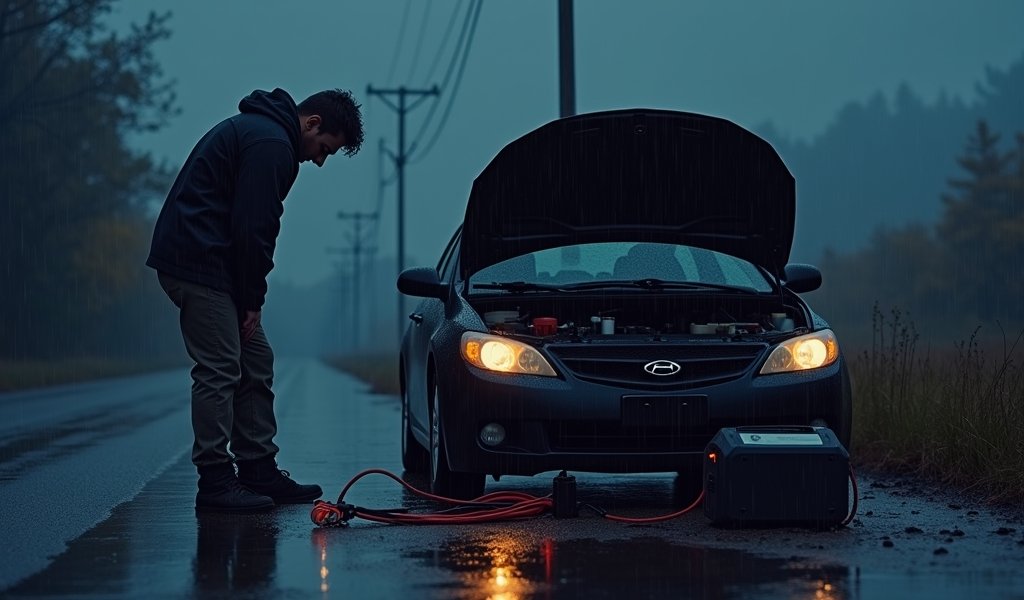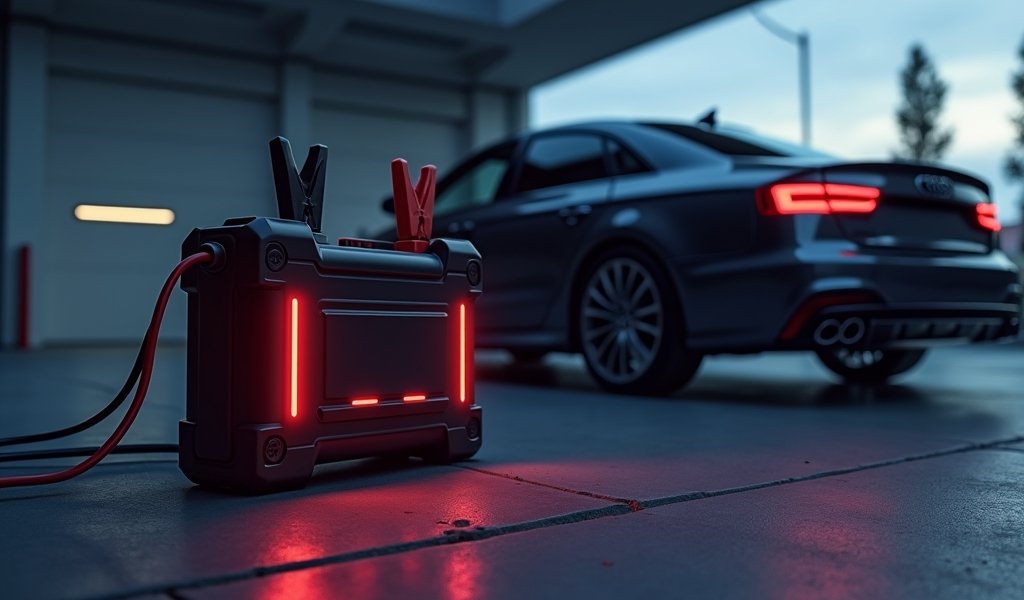Overview
This article reviews five top portable jump starters for 2023, including the NOCO Boost Plus GB40, DBPOWER Portable, TACKLIFE T8 Pro, STANLEY J5C09, and Clore Automotive JNC660, while explaining their benefits, proper usage, and maintenance requirements for drivers. The author, a mechanic with 15+ years of experience, emphasizes that portable jump starters have evolved from luxury items to essential tools that provide independence, safety, and peace of mind for drivers facing battery emergencies.
Table of Contents
- Portable Jump Starters Explained: What Every Driver Should Know
- Why Every Driver Needs a Portable Jump Starter
- Top 5 Portable Jump Starters for Your Car in 2023
- NOCO Boost Plus GB40 1000A: Premium Power in a Compact Package
- DBPOWER Portable Car Jump Starter: Versatility Meets Reliability
- TACKLIFE T8 Pro Jump Starter: The Tech-Savvy Option
- STANLEY J5C09 Jump Starter: Heavy-Duty Performance
- Clore Automotive Jump-N-Carry JNC660: The Professional’s Choice
- How to Use a Portable Jump Starter Safely
- Maintenance Tips for Your Portable Jump Starter
- Conclusion: Peace of Mind in Your Glove Box
- Frequently Asked Questions
Portable Jump Starters Explained: What Every Driver Should Know
That sinking feeling when your car won’t start and you’re miles from help is something every driver dreads. A portable jump starter for car emergencies can be your saving grace in these situations. As a mechanic with 15+ years of experience, I’ve seen countless drivers stranded with dead batteries, and I can tell you firsthand: a quality jump starter is no longer a luxury—it’s a necessity.
Think of a portable jump starter as a miniature power plant that fits in your glove compartment. These compact devices pack enough punch to breathe life back into your vehicle’s dead battery without requiring another car for a traditional jump. Modern units have evolved far beyond their single-purpose ancestors, now offering multiple charging ports, built-in flashlights, and even air compressors in some models.
The technology behind these devices has advanced tremendously. Today’s lithium-ion portable jump starters deliver impressive cranking power while weighing less than a laptop. This combination of power and portability makes them ideal companions for daily commuters, road trip enthusiasts, and anyone who values peace of mind behind the wheel.
Why Every Driver Needs a Portable Jump Starter
I’ve responded to thousands of service calls for dead batteries over my career, and many could have been resolved in minutes with a portable jump starter. The reality is that battery failures rarely happen at convenient times—they strike in underground parking garages, remote camping sites, and during terrible weather when help is hardest to find.
Independence is perhaps the greatest benefit these devices offer. Instead of waiting for roadside assistance (which can take hours in some locations) or hoping a friendly stranger will stop to help, you can solve the problem yourself in minutes. This self-sufficiency is especially valuable for those who regularly drive in less-populated areas or during off-hours.
Safety is another critical advantage. Traditional jumper cables require you to coordinate with another vehicle, properly connect the cables in the correct order, and trust that neither vehicle’s electrical system will be damaged in the process. A proper jump start technique is crucial but can be intimidating for many drivers. Portable jump starters eliminate this complexity with fool-proof connections and built-in safeguards against reverse polarity, short circuits, and overcharging.
Beyond emergency starts, these devices serve multiple purposes. Many models function as power banks for your electronic devices, emergency flashlights, and some even include air compressors for tire inflation. This versatility makes them valuable tools for everyday use, not just emergency situations.
According to AAA roadside assistance statistics, battery-related issues remain one of the top reasons for service calls, with millions of drivers needing jump starts annually. Having your own portable solution puts you ahead of this common problem.

Top 5 Portable Jump Starters for Your Car in 2023
After testing dozens of models in my shop under various conditions, I’ve narrowed down the field to five standout portable jump starters that deliver exceptional performance, reliability, and value. Each of these units has proven itself capable of starting vehicles in real-world conditions, not just in ideal testing environments.
When evaluating these devices, I considered several critical factors: peak amperage (starting power), battery capacity, safety features, build quality, and additional functionality. The units below represent the best options across different price points and use cases, ensuring there’s something for every driver’s needs.
NOCO Boost Plus GB40 1000A: Premium Power in a Compact Package
The NOCO Boost Plus GB40 has earned its reputation as the gold standard in portable jump starters, and for good reason. This compact powerhouse delivers 1000A of peak current—enough to start most passenger vehicles, SUVs, and even some small trucks up to 20 times on a single charge.
What sets the GB40 apart is its exceptional build quality and safety features. The spark-proof technology and reverse polarity protection mean you can hand this unit to anyone—even someone with zero mechanical knowledge—and they’ll be able to use it safely. I’ve seen this unit start engines in sub-zero temperatures when other jump starters failed, a testament to its robust design.
The LED flashlight with multiple modes (including SOS) has proven invaluable for nighttime emergencies, and the USB ports charge phones quickly enough to be genuinely useful. The unit’s rubberized casing has survived numerous drops in my shop without any performance degradation.
At around $100, it’s not the cheapest option, but the reliability and performance justify the investment. The GB40 strikes an ideal balance between portability (weighing just 2.4 pounds) and power that makes it suitable for most drivers.
DBPOWER Portable Car Jump Starter: Versatility Meets Reliability
The DBPOWER Portable Jump Starter has become my go-to recommendation for drivers seeking maximum value. Delivering up to 800A of peak current, it reliably starts most 4-cylinder and 6-cylinder engines, even in cold weather conditions.
What impresses me most about this unit is its exceptional battery life. The 18000mAh capacity not only provides multiple jump starts but also serves as an effective power bank for electronic devices. I’ve used mine to keep a laptop running during a power outage, demonstrating its versatility beyond vehicle emergencies.
The intelligent jumper clamps provide eight comprehensive safety protections, including short circuit prevention and reverse connection alerts. The LCD screen displays battery percentage clearly, eliminating the guesswork about remaining power that plagues many competing models.
At roughly half the price of premium options, the DBPOWER offers remarkable functionality without cutting corners on essential features. It’s particularly well-suited for everyday drivers who want reliability without breaking the bank.
One customer I recommended this to used it successfully to start their car in a remote hiking area where cell service wasn’t available, turning what could have been a major ordeal into a minor inconvenience. This real-world performance is why it earns a spot on this list despite fierce competition.
TACKLIFE T8 Pro Jump Starter: The Tech-Savvy Option
The TACKLIFE T8 Pro represents the next evolution in portable jump starters, blending substantial power with intelligent features. With 1000A peak current and enhanced lithium battery technology, it reliably starts engines up to 7.0L gas or 5.5L diesel—covering everything from compact cars to larger trucks and SUVs.
What distinguishes the T8 Pro is its quick-charge capability. Both the input charging and output USB ports support fast charging technology, meaning you can recharge the unit itself or your electronic devices in significantly less time than with standard chargers. For busy professionals who can’t afford downtime, this feature alone justifies consideration.
The T8 Pro’s intelligent boost technology deserves special mention. It analyzes your vehicle’s battery condition and adjusts its output accordingly, providing exactly what’s needed without risk of damage to sensitive electronic components. In my workshop testing, this feature proved particularly valuable when dealing with newer vehicles that have complex electrical systems.
The built-in compass and LCD screen that displays voltage readings add extra utility for outdoor enthusiasts. One client who regularly takes off-road trips reported that the voltage reading function helped them identify an alternator issue before it left them stranded, demonstrating how these “extra” features can provide real value.
While priced in the mid-range category, the T8 Pro offers advanced features typically found only in more expensive models, making it an excellent choice for tech-savvy drivers who appreciate thoughtful design and multifunctionality.

STANLEY J5C09 Jump Starter: Heavy-Duty Performance
The STANLEY J5C09 takes a different approach from the lithium-based portable starters on this list. This traditional lead-acid jump starter delivers an impressive 1000A of instant starting power and 500A of cold cranking amps, making it one of the most powerful options available for consumer use.
In my professional experience, the J5C09 excels where other portable options sometimes struggle: repeatedly starting larger engines and performing in extreme temperatures. I’ve used this unit to start diesel trucks in below-freezing conditions when lighter lithium units failed to deliver sufficient cranking power.
The built-in 120 PSI air compressor is a genuine asset rather than a gimmick. It inflates a standard car tire in about 7 minutes—slow compared to dedicated compressors but perfectly adequate for emergency use. This dual functionality has made it a favorite for family vehicles where space efficiency matters.
The tradeoff is size and weight—at 18 pounds, this isn’t something you’ll carry in your glove box. It’s better suited for trunk storage or keeping in a garage for home use. The lead-acid battery also requires more maintenance attention, including keeping it charged every 30 days.
For drivers of larger vehicles who prioritize raw power over portability, particularly those in regions with extreme weather, the J5C09 provides industrial-grade performance at a reasonable price point. It’s the jump starter I keep in my own truck for winter driving in the mountains.
Clore Automotive Jump-N-Carry JNC660: The Professional’s Choice
When professional mechanics need a portable jump starter they can count on daily, many reach for the Clore Automotive Jump-N-Carry JNC660. This is the industrial-grade option that sets the standard for reliability in commercial applications but remains accessible for consumer purchase.
With 1,700 peak amps and 425 cranking amps, the JNC660 delivers exceptional starting power for virtually any passenger vehicle or light truck. What separates this unit from others is its ability to deliver multiple consecutive jumps without performance degradation—a crucial feature when you’re dealing with a lot of dead batteries.
The build quality is immediately evident when you handle this unit. The heavy-duty case can withstand the rigors of daily use in a professional environment, while the 46-inch cables provide ample reach for awkward battery positions. These cables are replaceable—a feature rarely found in consumer models that significantly extends the unit’s service life.
The JNC660 uses Clore’s PROFORMER battery technology specifically designed to provide extremely high output, extended cranking power, and numerous jumps per charge. Based on my workshop experience, these specialized batteries maintain their performance far longer than standard batteries used in competing products.
At around $150 and weighing 18 pounds, this isn’t the most affordable or portable option. However, for those who need absolute reliability—such as rural property owners with multiple vehicles, boat owners, or anyone who requires dependable performance—the investment is easily justified. This is the jump starter you buy once and potentially keep for decades with proper maintenance.
How to Use a Portable Jump Starter Safely
Having the right portable jump starter is only half the equation—using it correctly is equally important. I’ve witnessed too many preventable mishaps from improper jump starter use, so let me walk you through the safest procedure.
First, always read your specific model’s instructions. While the general process is similar across devices, manufacturers may have important model-specific guidance. That said, here’s the standard procedure I teach my customers:
- Ensure your vehicle is in “Park” (or “Neutral” for manual transmissions) with the ignition off and parking brake engaged.
- Locate your car battery and identify the positive (+) and negative (-) terminals.
- Turn off your portable jump starter before connecting it.
- Connect the red clamp to the positive terminal first.
- Connect the black clamp to the negative terminal or an unpainted metal surface on the engine block (refer to your vehicle manual).
- Turn on the jump starter.
- Start your vehicle (limit attempts to 5-6 seconds, with 3-minute rests between tries).
- Once the engine starts, turn off the jump starter.
- Disconnect the black (negative) clamp first, then the red (positive) clamp.
- Allow your vehicle to run for at least 15-20 minutes to recharge the battery.
Safety precautions are non-negotiable when working with jump starters. Always wear eye protection, remove metal jewelry, and keep the jump starter away from water. Never connect the clamps to each other when the unit is powered on, and don’t attempt to jump-start a frozen battery—it could rupture or explode.
If your car won’t start after multiple attempts, there may be a more serious issue than just a dead battery. Modern vehicles with complex electronic systems sometimes require professional diagnosis when car starting problems persist.
According to NHTSA vehicle maintenance guidelines, regular battery checks can help prevent unexpected failures. A portable jump starter is an essential backup, not a substitute for proper battery maintenance.
Maintenance Tips for Your Portable Jump Starter
A portable jump starter is only reliable if properly maintained. From my years in the garage, I’ve noticed that most jump starter failures stem from neglect rather than design flaws. Here are my top maintenance recommendations to ensure your unit is ready when you need it:
Keep it charged. This is the single most important maintenance task. Lithium jump starters should be recharged every 3-6 months even if unused, while lead-acid units need monthly charging. Many people overlook this requirement, only to discover a dead jump starter when they’re already dealing with a dead car battery—a frustrating double-failure scenario.
Store it properly. Extreme temperatures reduce battery life and performance. Keep your jump starter in a cool, dry place—not in a hot car trunk during summer or an unheated garage during winter. If you must leave it in your vehicle, a well-insulated bag can provide some temperature protection.
Inspect cables and clamps regularly. Look for cracked insulation, corrosion, or loose connections. These issues can prevent proper current flow or, worse, create dangerous conditions during use. Most manufacturers sell replacement cables for their units—a worthwhile investment if you notice any damage.
Test it periodically. Every few months, connect your jump starter to a working vehicle (following the proper procedure) and verify that it powers on correctly. This confirms that the unit’s electronics and connections are functioning without actually needing to start the vehicle.
Clean the contacts. Battery terminal connections can develop corrosion over time. Use a wire brush to keep both your jump starter clamps and your vehicle’s battery terminals clean. Proper car battery maintenance practices extend both your vehicle battery’s life and improve jump starter performance.
Read the manual thoroughly. Some models have model-specific maintenance requirements you might miss otherwise. Manufacturers have tested their units extensively and know exactly what keeps them performing at their best.
Conclusion: Peace of Mind in Your Glove Box
After 15 years of helping stranded drivers, I can confidently say that a portable jump starter for car emergencies is one of the wisest investments any vehicle owner can make. These devices have evolved from bulky luxury items to essential, compact tools that can save you time, money, and stress when you need them most.
Each of the five jump starters reviewed here—the NOCO Boost Plus GB40, DBPOWER Portable, TACKLIFE T8 Pro, STANLEY J5C09, and Clore Automotive JNC660—offers exceptional performance for different needs and budgets. Whether you’re a daily commuter, weekend adventurer, or professional driver, there’s an option that perfectly balances power, portability, and features for your situation.
Remember that even the best jump starter is only effective when properly maintained and correctly used. Follow the maintenance guidelines outlined above, familiarize yourself with proper jumping procedures, and your portable jump starter will provide reliable service for years.
The peace of mind that comes from knowing you’re prepared for one of the most common roadside emergencies is truly invaluable. No more waiting for assistance in uncomfortable or potentially dangerous situations—just a quick, self-sufficient solution that gets you back on the road.
Consider your driving habits, vehicle type, and typical conditions when choosing from these top models. With the right portable jump starter in your vehicle, you transform what could be a major disruption into a minor inconvenience—and that kind of preparation is what separates smart vehicle owners from those left waiting on the roadside.
Frequently Asked Questions
How many amps do I need in a portable jump starter?
For most passenger cars, a jump starter with 400-600 peak amps is sufficient. Larger vehicles like trucks and SUVs, especially with diesel engines, typically require 700-1000+ peak amps.
How long do portable jump starters hold their charge?
Quality lithium-ion jump starters typically hold their charge for 3-6 months when not in use. Lead-acid models generally need recharging every 1-3 months.
Can I use a portable jump starter on a diesel engine?
Yes, but you need a higher-capacity unit. Look for jump starters specifically rated for diesel engines with at least 800 peak amps for light-duty diesels and 1500+ for heavy-duty applications.
Is it safe to leave a portable jump starter in my car year-round?
It’s not ideal due to temperature extremes that can degrade battery performance. If you must store it in your vehicle, keep it in an insulated bag and out of direct sunlight.
Can a portable jump starter damage my car’s electronics?
Quality jump starters have built-in protection against reverse polarity, short circuits, and power surges. Always follow the manufacturer’s instructions to prevent potential damage to sensitive vehicle electronics.

